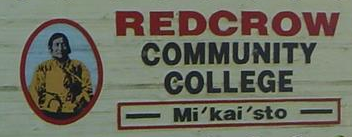Ki’piaapi – Anemone patens L. var wolfgangiana (Bess) Koch (Prairie Crocus; Gets old early; Early old Men)
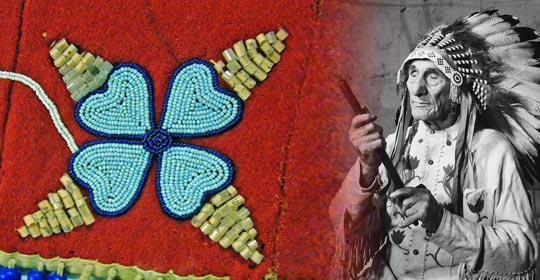
Flowers are often beaded onto clothing to remind us of our connection to plants.
▪ Glenbow Museum. (2005). Nitsitapiisinni Exhibit.
Calgary, Alberta: Blackfoot Gallery Committee.
(Photo courtesy of Glenbow Museum Archives NA-1757-13)
The Crocus by Marvin
I remember the story you told me about crocus. There was once an Indian boy ready to go through his ceremony of manhood in the early spring. After the traditional sweats of purification he was sent up into the hills with nothing but a buffalo robe, for three days of fasting and vision questing. The first night it became very cold, so he wrapped his robe tightly around himself and he heard a little voice say, “Thank you.” Surprised, looking around for the voice, he noticed a little white flower. It looked at him and said, “Don’t unwrap the robe it is cold out there.” The boy soon fell asleep, feeling just a little bit more secure, now that he wasn’t all alone. The next day he started talking to the flower and it kept him company as the long hours went by. The second night was just as cold and the flower was very grateful for the boy’s warm robe. On the third day, the boy was starting to get a bit concerned because he had not as yet had a vision. If he didn’t have a vision he would not become a man. The flower assured him that everything would be all right as they looked out together at the beautiful yellow sun, reflecting on top of the purple mountains. That night was the coldest of them all, they had to cuddle close in the robe to keep warm, but just before the dawn, a great vision came to the boy. He saw himself as a great medicine man, taking care of many tribes of people. In the morning he was so happy with his newfound power, feeling grateful for the friendship given to him by the flower, he told the flower it could have three wishes. The crocus said, “I would like to have the warmth and the beauty of the yellow sun at my heart, the grace of the purple mountains all around me and a heavy fur robe to keep me warm.” To this very day the children of this little crocus have been given all three to keep them warm and happy in the early spring.
Ki’piaapi
Ki’piaapi akohkotohtsipotsima’so’p. Ki’piaapi aotoomssaiski moistsii pisatssaisskiistsi mo Motoyi. Iitaisaisskiyaw spatsikoispahkoistsi. Iitowapistsiskitsi mo tattsikiaoksiahki Matsiyikkapisaiki’somm ki mo tattsikiaoksiahki Aapistsiskitsaato’si. Ma aakii a’yaksikamotas ihtaiksistsikimisstowa makohtsi’kinaikamotahsi.
Pasque Flower
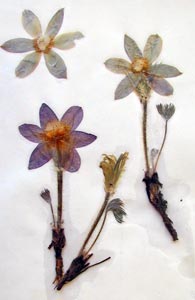
Anemone patens L. var wolfgangiana (Bess) Koch
Galileo Educational Network
*WARNING: The plants contain oil that is a powerful irritant. It is known to slow the heart when ingested and it is considered poisonous.
Pasqueflowers, or Prairie Crocus, are one of the first flowers of spring on our meadows and sandy hillsides. Sometimes you see their pale blue, mauve, white or light yellow heads peak up from the snow. They bloom from mid-April to mid-May. The flowers are about 4 cm when open on top of stems about 10 cm high. One of the names of the
Pasqueflower is “ears of the earth”. Some say the flowers listen for the coming of spring. Their gray green leaves grow after the flowers bloom. The whole plant is covered in little hairs, which protects it from insects.
In the past, jokes were played on people by offering the leaves as toilet paper. The leaves can sting, so after the person used them, their bottom would be sore! These leaves however, offered relief from rheumatism when made into a mush and placed on the inflamed areas. This is a good example of how well our elders knew the plants. Used in the wrong way or in the wrong dose, it could hurt you. Used the right way, in just the right dose, it can help you.
The roots were also brewed for women to help them deliver a baby sooner.
Anémone pulsatille
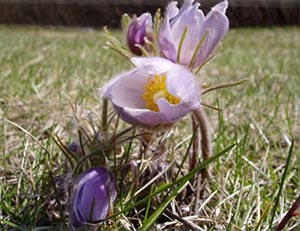
Anemone patens L. var wolfgangiana (Bess) Koch
© 2001 Marian Hood
*AVERTISSEMENT : Cette plante contient de l’huile fortement irritante. Si elle est ingérée, elle ralentit le coeur. Elle est considérée comme toxique.
L’anémone pulsatille est l’une des premières fleurs à faire son apparition au printemps. Elle pousse dans nos prés et nos collines sablonneuses. Parfois, nous voyons sa tête sortir de la neige. Ses fleurs sont de couleur bleu clair, jaune clair, violette ou blanche. Cette plante fleurit de la mi-avril à la mi-mai. Une fois ouvertes, ses fleurs mesurent environ 4 centimètres et ses tiges, environ 10 centimètres de haut. Cette plante est également surnommée “oreilles de la terre”, parce qu’on dirait que ses fleurs écoutent l’arrivée du printemps. Ses feuilles d’un gris-vert poussent après ses fleurs. Toute cette plante est couverte de petits poils qui la protège des insectes.
Anciennement, nous faisons des mauvais coups aux gens en leur donnant les feuilles de cette plante pour qu’ils s’en servent comme papier de toilette. Ces feuilles piquent, ce qui leur donnait mal aux fesses! Par contre, en forme de bouillie, ces feuilles aidaient à soulager le rhumatisme si nous placions la bouillie sur les parties irritées du corps. Ceci est un bon exemple de la façon dont nos aînés connaissaient bien les plantes. Si elles n’étaient pas utilisées à bon escient ou dans la bonne dose, elles pouvaient nous nuire. Si elles étaient utilisées à bon escient ou dans la bonne dose, elles pouvaient nous aider.
Nous pouvions aussi infuser les racines de cette plante pour provoquer l’accouchement d’une femme.
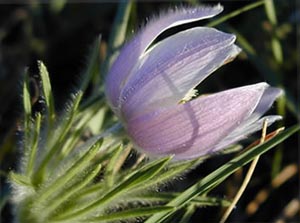
Anemone patens L. var wolfgangiana (Bess) Koch
© 2001 Marian Hood
- Brown, Annora. (1954). Old Man’s Garden. Vancouver, British Columbia: Evergreen Press Limited.
- Kerik, Joan. (1979). Living With The Land: Use of Plants by the Native People Of Alberta. Edmonton, Alberta: Provincial Museum of Alberta.
- Tilford, Gregory. (1997). Edible and Medicinal Plants Of The West. Missoula, Montana: Mountain Press Publishing Company.
- Vance, F.R., Jowsley, J.R. & Mclean, J.S. (1984). Wildflowers Across The Prairies. Saskatoon, Saskatchewan: Western Producer Prairie Books.



